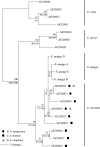A rapid loss of stripes: the evolutionary history of the extinct quagga
- PMID: 17148190
- PMCID: PMC1617154
- DOI: 10.1098/rsbl.2005.0323
A rapid loss of stripes: the evolutionary history of the extinct quagga
Abstract
Twenty years ago, the field of ancient DNA was launched with the publication of two short mitochondrial (mt) DNA sequences from a single quagga (Equus quagga) museum skin, an extinct South African equid (Higuchi et al. 1984 Nature312, 282-284). This was the first extinct species from which genetic information was retrieved. The DNA sequences of the quagga showed that it was more closely related to zebras than to horses. However, quagga evolutionary history is far from clear. We have isolated DNA from eight quaggas and a plains zebra (subspecies or phenotype Equus burchelli burchelli). We show that the quagga displayed little genetic diversity and very recently diverged from the plains zebra, probably during the penultimate glacial maximum. This emphasizes the importance of Pleistocene climate changes for phylogeographic patterns in African as well as Holarctic fauna.
Figures


References
-
- Bennett D.K. Stripes do not make a zebra. Part I: a cladistic analysis of Equus. Syst. Zool. 1980;29:272–287.
-
- Birungi J, Arctander P. Molecular systematics and phylogeny of the Reduncini (Artiodactyla: Bovidae) inferred from the analysis of mitochondrial cytochrome b gene sequences. J. Mamm. Evol. 2001;8:125–147.
-
- Dawson A.G. Routledge; New York: 1992. Ice age earth: late Quaternary geology and climate.
-
- Flagstad Ø, Syvertsen P.O, Stenseth N.C, Jakobsen K.S. Environmental change and rates of evolution: the phylogeographic pattern within the hartebeest complex as related to climatic variation. Proc. R. Soc. B. 2001;268:667–677. doi:10.1098/rspb.2000.1416 - DOI - PMC - PubMed
-
- Groves C.P, Bell C.H. New investigations on the taxonomy of the zebras genus Equus, subgenus Hippotigris. Mamm. Biol. 2004;69:182–196.
Publication types
MeSH terms
Substances
LinkOut - more resources
Full Text Sources

